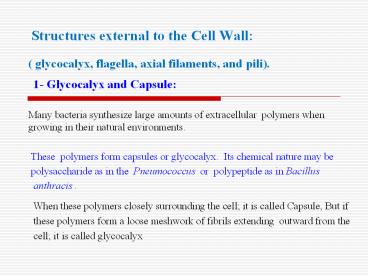Structures external to the Cell Wall: - PowerPoint PPT Presentation
Title:
Structures external to the Cell Wall:
Description:
Spore morphology Endospore structure Spores of Bacillus . Title: Structures external to the Cell ... The Bacterial Cell Wall: The Gram-positive cell envelope: ... – PowerPoint PPT presentation
Number of Views:102
Avg rating:3.0/5.0
Title: Structures external to the Cell Wall:
1
Structures external to the Cell Wall
- ( glycocalyx, flagella, axial filaments, and
pili). - 1- Glycocalyx and Capsule
- Many bacteria synthesize large amounts of
extracellular polymers when growing in their
natural environments. - These polymers form capsules or glycocalyx.
Its chemical nature may be - polysaccharide as in the Pneumococcus or
polypeptide as in Bacillus - anthracis .
- When these polymers closely surrounding the
cell it is called Capsule, But if - these polymers form a loose meshwork of fibrils
extending outward from the - cell it is called glycocalyx
2
Glycocalyx and Capsule
- a
3
a
- Function of capsule or glycocalyx is to protect
bacterial cells from - phagocytosis.
- Capsule and glycocalyx can be demonstrated by
light microscope using of - capsule stain of bacterial smear
- or India ink wet mount.
- 2-Flagella and motility
- Motile bacteria possess filamentous appendages
known as flagella, which - act as organs of locomotion.
- The flagellum is a long, thin filament, twisted
spirally in an open, regular - waveform.
- It is about 0.02 µm thick and is usually several
times the length of the bacterial cell. - According to the species, there may be one, or
up to 20, flagella per cell.
4
a
- Flagella may be classified according to there
arrangement as follow - 1- Monotrichous (single polar flagellum).
- 2- Lophotrichous (tuft of polar flagella).
- 3- Perituichous (flagella distributed over the
cell). - 4- Amphitrichous (one flagellum at each side
of cell).
5
Flagella are associated with chemotaxis process
(chemical attraction) of bacterial cells that
contribute in disease pathogenesis.
- Monotrichous flagellum
Lophotrichous flagella -
-
Peritrichous flagella
6
3- Axial filaments
- Some types of bacteria have a flagellum that lie
inside periplasmic space - (over cell wall peptidoglycan and under the
outer membrane). - This flagellum called endoflagellum or axial
filament. - The endoflagella are more than half the length of
the organisms and run along the axial aspect of
the spiral body. - They are responsible for rotary motility of
these organisms.
7
4- Pili and Fimbriae
- Many bacteria possess filamentous appendages
termed pili or fimbriae. - These are more numerous than flagella (e.g.
100-500, being borne surrounding each cell). - They are from 0.1 to 1.5 µm in length and having
a uniform width between 4 and 8 nm. - Pili are important in mediating adhesion between
the bacteria - and host cells ( hemagglutination phenomenon).
- Another type of pili called sex pili is longer
and initiate the - process of conjugation ( genetic material
exchange between - bacteria).
8
Pili and Fimbriae
- a
9
The Bacterial Cell Wall
- The cell envelope
- The layers that surrounding bacterial cell are
called the cell envelope. - The Gram-positive cell envelope
- It is composed from three layers the
cytoplasmic membrane, a thick - peptidoglycan layer and a variable outer layer
called capsule. - The Gram-negative cell envelope
- It is composed from inner membrane (cytoplasmic
membrane), the outer - membrane, the peptidoglycan sheet, and capsules
if present. - Periplasmic space separates outer and inner
membrane.
10
The Gram-positive cell envelope
The Gram-negative
cell envelope
- a
11
The cell wall
- It is the outer covering layer of the bacterial
cell. - It is a rigid structure consisting of two layers
in Gram-positive bacteria and - of three layers in Gram-negative.
- In Gram-positive bacteria, it is composed from
pepeidoglycan (thick) layer - and the associated capsule if present.
- Peptidoglycan is long polymers of two sugar
derivatives, NAG (N-Acetyl - Glucosamine) and NAM (N-Acetyl Muramic acid) with
side chains of four - alternating D and L amino acids attached to NAM.
12
The cell wall structure
- a
13
Structures internal to the Cell WallThe
cytoplasmic membrane
- It is consisting of phospholipids bilayers and
proteins (integral and peripheral protein). - The major functions of
- cytoplasmic membrane
- are
- 1- Selective permeability and
- transport of solutes.
- 2- Electron transport by its
- electron transport chain.
- 3- Excretion of hydrolytic
- exoenzymes.
14
Spores and Sporulation
- To enhance survival during periods of
environmental hostility, some gram-positive rods
undergo profound structural and metabolic
changes. - These results in the formation of a endospores
inside the original cell. - Sporulation
- Repackaging a copy of bacterial DNA into a new
multilayered cellular envelope that contains very
little water and reduced metabolic activity.
15
Spore Germination
- Destruction of spore coat and cortex due to heat
or pH variation to produce vegetative bacterial
cell which begins binary fission. - Medical significance of sporulation
- Some of the pathogenic bacteria are
spore-formers. - Spores of these microbes can remain viable for
many years. - If the spore inoculated in wounds, it will
germinate to produce - Infection.
- Example of spore forming bacteria
- 1-Bacillus species.
- 2-Clostridium species.
16
Spore morphology
- Endospore structure
Spores of Bacillus

